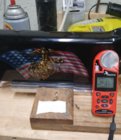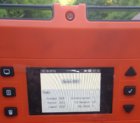I feel like there is some confusion here that centers around the two basic tuning methods and then the expectations at short range v long rang.
Tuning for positive compensation (PC) is very specific, the science shows us that the only time the bullets (which travel at various speeds of often quite large ES) will all converge at the same vertical point (or very close to) is at the tuned distance, whatever that may be. Imagine a series of ballistic curves, the slower bullets have slightly more in terms of trajectory as they leave the barrel later on its harmonic rise than the faster ones but because of these different bullet release/exit points at different trajectories they converge somewhere they are meant to at a specific tuned distance, usually long range.
If we plotted these curves they would all rise above the line of sight then drop back over it again at our zero/tuned distance, at all other times the bullets are on varying trajectories/flight paths so if they land on any other target at any other distance the groups wont be optimised, the further before or after the zero/tuned range the more vertical difference there will be. As such I would never expect a PC tuned 1000yd rifle to shoot small at 100yds, when I say small I mean aggs in the low .2s or less, it just can't happen, I would also expect to see vertical dispersion in the group but exactly how much I dont know, it might show up better at say 300yds. If a rifle dis shoot small at all ranges up to the tuned distance then PC couldn't be happening.
I think we are past the stage of debating if PC exists or works, there are enough guys proving it time and again and having also proven it at less than my required 1000yds I have no doubt it works, sadly its very distance specific

The other method of tuning (which this thread was aimed at) is one of shooting small groups at 100yds then taking them out to 200 and 300yd and again looking for small groups in the sub 0.25MOA range. From there we would be hoping/expecting that the groups also held together at 600yds and then 1000yds and would continue tuning to optimise within the realms of what our MV extreme spreads will allow. If a rifle has been tuned this way and shoots really well at 600yds there is more than an expectation it would also shoot well at 100, 300 and 1000 and what holds the load back would be our ES in terms of vertical dispersion.
The guys who are tuning for PC and can hold in the 1s for vertical at 1000yds have an advantage as in their case the ES doesn't matter, every bullet flies on its own trajectory until it converges at the target/tuned distance. Those tuning in the other manner have to then ensure they can hold very tight ES tolerances in low single figures and hope the BC of every bullet is the same to achieve the same level of vertical dispersion.
Based on the science its clear to see that if you can tune for PC at your competition distance and have the facilities, skills and weather window it would be the way to go but many of use dont have the facilities.
So, since I dont have the 1000yd range Im back where I started

My plan is to use my normal 100yd method to establish a happy powder/bullet combo that shows me sub 0.25MOA accuracy then take it back to 300yds. I will also be fitting a barrel tuner to add an extra dimension to fine tuning. Now if anyone would like to add to my thoughts or share any experience of bringing the barrel tuner in Im all ears













